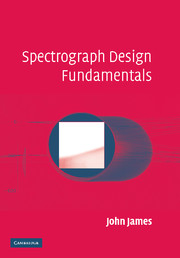Book contents
- Frontmatter
- Contents
- Preface
- Acknowledgements
- 1 A brief history of spectroscopy
- 2 The relevant regions of the electromagnetic spectrum
- 3 Geometrical optics
- 4 Optical aberrations
- 5 Fourier transforms: a brief revision
- 6 Physical optics and diffraction
- 7 The prism spectrograph
- 8 The plane grating spectrograph
- 9 The concave grating spectrograph
- 10 The interference spectrograph
- 11 The multiplex spectrometer
- 12 Detectors
- 13 Auxiliary optics
- 14 Optical design
- 15 Mechanical design and construction
- 16 Calibration
- 17 The alignment of a spectrograph
- Appendix 1 Optical aberrations
- Appendix 2 Wavelengths of spectral lines for calibration
- Appendix 3 The evolution of a Fabry–Perot interference spectrograph
- Appendix 4 The common calibration curve in silver halide spectrophotometry
- Bibliography
- Index
Preface
Published online by Cambridge University Press: 02 September 2009
- Frontmatter
- Contents
- Preface
- Acknowledgements
- 1 A brief history of spectroscopy
- 2 The relevant regions of the electromagnetic spectrum
- 3 Geometrical optics
- 4 Optical aberrations
- 5 Fourier transforms: a brief revision
- 6 Physical optics and diffraction
- 7 The prism spectrograph
- 8 The plane grating spectrograph
- 9 The concave grating spectrograph
- 10 The interference spectrograph
- 11 The multiplex spectrometer
- 12 Detectors
- 13 Auxiliary optics
- 14 Optical design
- 15 Mechanical design and construction
- 16 Calibration
- 17 The alignment of a spectrograph
- Appendix 1 Optical aberrations
- Appendix 2 Wavelengths of spectral lines for calibration
- Appendix 3 The evolution of a Fabry–Perot interference spectrograph
- Appendix 4 The common calibration curve in silver halide spectrophotometry
- Bibliography
- Index
Summary
Thirty-eight years ago, together with my colleague the late Robert Sternberg, I wrote a book entitled The Design of Optical Spectrometers. It described the state of the art as it was at that time after the great advances which had come in the previous ten years, and it was intended for people who wished to build a spectrometer tailored to a specific purpose, where perhaps one of the commercial designs was inadequate, unsuitable, unnecessarily cumbersome, or expensive.
When at last the time came to consider a new edition it became clear that the technology had changed so much that the classical optical spectrometer, in the sense of monochromator, was more or less obsolete and that later developments such as the desktop computer and the charge-coupled device had restored the spectrograph to its former eminence. The restoration in noway annulled the optical improvements of the previous 30 years but new constraints posed new problems in design. These problems are now solved and the solutions are presented here.
The fundamentals of optical design have not changed, but the constraints are now all different, and such properties as flat fields are needed where before they could be largely ignored; and focal ratios matter again when previously we could design everything so that such trivia as spherical aberration and coma could be neglected.
- Type
- Chapter
- Information
- Spectrograph Design Fundamentals , pp. ix - xPublisher: Cambridge University PressPrint publication year: 2007



